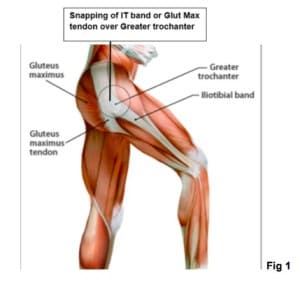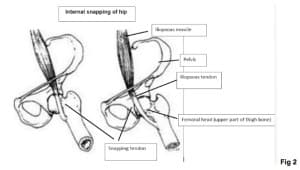A snapping hip is a condition in which snapping or popping sensation is felt or heard over the hip area while walking, getting in and out of a chair or car, or when swinging the leg around. Snapping happens when tightened muscle or tendon moves over bony prominence of hip. It is often seen in athletes and especially dancers. The muscles in the pelvis and hip help stabilize the joint and allow for mobility. When the muscles tighten they act as rubber bands. Movement of the muscle over an area of bone that sticks out creates this snapping sensation or sound.
CAUSES AND TYPES
It can be external, internal and intra-articular causes of snapping.
External snapping is the most common type and is caused by posterior iliotibial band (IT band) or anterior border of gluteus maximus muscle (butt muscle) slipping over greater trochanter (side prominence of thigh bone near the side pocket of pants). This type of snapping is known as visible obviously and can be seen over the side of the hip even from across the examination room. (Fig 1)
Fig 1
Internal snapping is caused by iliopsoas tendon snapping over bony prominence over the front of femoral head (upper part of thigh bone in joint). This type of snapping is loud and can be heard across the exam room when patient swings around the leg. (Fig 2)
Fig 2
Intra-articular snapping is caused by hip labral tears (ring cushion in the hip), loose bodies or cartilage flaps or other intra-articular causes (see labral tear section for detail).
SYMPTOMS:
Aside from feeling, hearing or visualizing a snap, some patients may also experience pain. Bursitis, which is inflammation of fluid-filled sacs which cushion bone against soft tissue, can occur from continuous snapping of tendon over bone.
DIAGNOSIS:
History and physical examination through various hip movements can reveal if and which muscle is involved. Ultrasound may also be helpful in determining the cause. An MRI can be used to rule out other hip pathologies.
TREATMENT:
There are both non-surgical and surgical treatment options if there is pain involved with the snapping. Initially, the physician may discuss altering activities that may contribute to or worsen the condition. If pain persists, physical therapy and steroid injections (in hip trochanter bursa in case of trochanter bursitis or in iliopsoas bursa if iliopsoas bursitis) can be useful.
When these conservative treatments fail to relieve the pain, surgery may need to be considered. These include:
HIP ARTHROSCOPY
Two to four small incisions (key hole) are made and an arthroscope (camera) is introduced into the hip and the pathology (cause of snapping) is addressed accordingly, like the repair of a labral tear, loose body removal, release of tight iliopsoas tendon, release of tight IT band and trochanteric bursa excision.
OPEN PROCEDURE
The procedure can be done open as well by making a longer incision over the hip. This is can be recommended depending on the extent of the problem.
RECOVERY AFTER SURGERY
Hip arthroscopy is a same day procedure. Physical therapy is started within a week or two depending on pain, healing of incision and extent of surgery. PT is usually recommended for 3 to 6 months after surgery depending on improvement in range of motion and strength gained.
_________________________________
EXPERIENCING PAIN? DO YOU HAVE AN INJURY?
Our Specialists are here to help.
Book an appointment with NYC’s best orthopedic specialists to discuss your condition. Fill out the form below and you will receive a call from our office within 5-10 minutes. We’ll book an appointment at a time and location that work for you, and send you a reminder by email.











